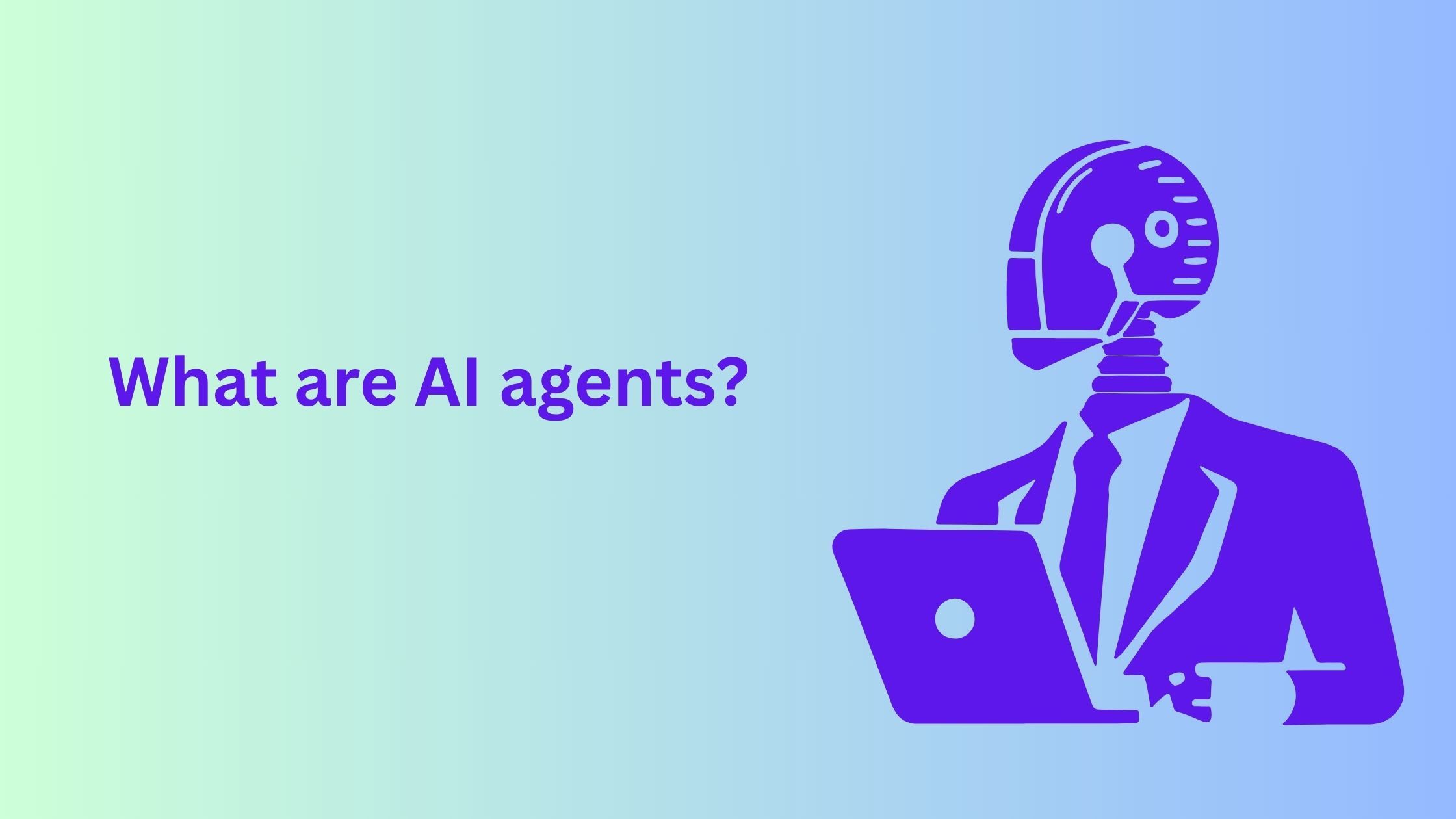What are AI agents: Everything You Should Know

Iron Man had Jarvis. AI agents are getting close to that, minus the billion-dollar suit. They may not save the world, but they will schedule your meetings, write your emails, and stop you from rage-tweeting your boss at 2 AM.
And unlike Steve from accounting, they won’t give a passive-aggressive sigh when you forget to say thank you.
We can already see this in platforms like Activepieces, which is leading in using AI agents to automate complex workflows and streamline operations with minimal code. This democratizes automation, putting powerful tools once reserved for developers into the hands of everyday users.
In this blog, we’ll dive into what AI agents are, how they work, real-world examples of their use, and how you can start leveraging them to automate your work even if you’re not Tony Stark.
What Is an AI Agent?
… and why are they suddenly everywhere?
An AI agent is a tool built with artificial intelligence that perceives its environment (digital environment in our case), processes that input, and takes action to achieve specific goals, without needing constant manual intervention. Think of it as the difference between a GPS and a self-driving car. One tells you where to go; the other gets you there.
Key Traits of an AI Agent
Autonomy
AI agents don’t wait around for you to tell them what to do next. Unlike basic AI programs, AI tools, or scripts, they can operate independently, observing, planning, and executing tasks without constant input. Basically, they’re the interns who actually get things done without pinging you every 3 minutes on Slack.
Goal-Oriented Behavior
Every AI agent has a mission, whether that’s scheduling your meetings, optimizing your warehouse, or managing 15 browser tabs so you don’t crash Chrome again. Their actions always aim at accomplishing a predefined goal.
Adaptability
Real AI agents are not just smart. They learn from past experiences, adapt to new inputs, and improve performance over time. Unlike simple AI software that does one thing and calls it a day till you prompt it again, agents evolve.
Here’s the difference in simpler terms:
A basic AI tool or script might read some data and spit out a result. That’s it. No thinking, no learning, no “Hey, maybe I can do this better next time.”
But an AI agent thinks. It sees something new, adjusts, and keeps working toward its goal. It’s running a loop of perception → reasoning → action—kind of like your brain.
How Do AI Agents Work?
The operation of every AI agent is a continuous feedback loop often described as the Sense–Think–Act cycle. This iterative process allows agents to interact with their environment, process information, make intelligent decisions, and execute actions to achieve their goals.
Now let's look at each stage of the cycle
- Sense (Perception)
The first stage of the cycle involves the AI agent gathering information from its environment. This can be compared to an extent with how humans use their senses. For an AI agent, this sensing can involve a wide variety of data inputs:
- Data input from APIs: Agents frequently connect to external services and databases via Application Programming Interfaces (APIs). For instance, an agent managing customer support might pull customer data from a CRM API or product information from an e-commerce API.
- Webhooks: Webhooks are event-driven messages sent from one system to another when a specific event occurs. Unlike APIs that require constant requests or polling, webhooks automatically notify your system in real time when a specific event happens. They act as triggers for agents. For example, alerting an agent when a new email arrives, a file is uploaded, or a payment is processed.
- User input: Direct commands or queries from a human user also serve as a form of perception, providing the agent with new information or tasks.
- (Think) Reasoning
Once an AI agent has perceived its environment, the think phase begins. This is where the raw data is processed, analyzed, and used to make informed decisions. This internal processing often uses a combination of advanced AI software components:
- Machine Learning Models: Example, Large Language Models (LLMs) allow agents to understand natural language, generate human-like text, summarize information, and even perform complex reasoning tasks based on patterns learned from vast datasets. Other ML models might be used for prediction, classification, or anomaly detection.
- Rule Engines: For specific logical operations or compliance requirements, agents may employ rule engines that execute predefined rules based on certain conditions (e.g., "if X happens, then do Y").
- Planning Algorithms: For more complex, multi-step goals, agents use planning algorithms to devise a sequence of actions that will lead to the desired outcome. This involves considering various paths, potential obstacles, and the likelihood of success for each step.
- Knowledge Graphs & Databases: Agents might query internal or external knowledge bases to retrieve relevant facts, relationships, and context necessary for decision-making.
- Act (Action)
The final stage of the loop involves the AI agent executing the decisions it has made. This is where the agent impacts its environment. AI agents are designed to use various tools to perform their tasks:
- Invoking Tools: This is a critical aspect. AI agents don't perform every function themselves. Instead, they act as intelligent orchestrators, calling specialized external tools or software to carry out specific operations.
For example, an agent might use an email API to send a notification, or it could invoke a Python script to perform a data transformation.
- Updating Databases: Agents can store new information, modify existing records, or log their activities within databases, ensuring data consistency and traceability.
- Triggering Workflows: Agents can initiate other automated processes or workflows. For example, an Activepieces agent identifying a high-priority customer issue might trigger a workflow that creates a support ticket, notifies a human agent, and sends an automated apology email.
AI Agents vs. Bots vs. GPT
The terms "AI," "AI agents," "bots," and "GPT" are often used interchangeably, but they are different. Understanding their differences is key to appreciating the unique capabilities of each.
AI Agent vs. Bot
What is the difference between an AI agent and a bot?
- Bots (Robots/Chatbots): Generally, a bot is an automated AI program designed to perform specific, repetitive tasks. Bots typically follow predefined rules or scripts. They excel at narrow, well-defined functions like responding to FAQ questions on a website, sending automated emails, or performing routine data entry. They are reactive (meaning they have to be triggered to act) and operate within strict parameters. If an unexpected situation arises, a bot will often fail or require human intervention because it lacks the capacity to adapt beyond its programmed instructions.
- AI Agents: In contrast, an AI agent is a more sophisticated and autonomous entity. While a bot merely follows instructions, an AI agent is designed to perceive its environment, make decisions, and adapt its behavior to achieve goals, even in dynamic or unpredictable situations. They can learn, reason, and often leverage a wider range of tools and software to execute complex, multi-step tasks. The key distinction lies in their capacity for adaptation and goal-oriented autonomy versus a bot's rigid script-following.
AI vs. AI Agent
What is the difference between AI and AI agents?
- Artificial Intelligence (AI): AI is a broad definition for smart computers that can perform tasks requiring human-like intelligence. This covers everything from machine learning algorithms and deep neural networks to robotics, natural language processing, computer vision, and expert systems. It's the foundation.
- AI Agents: An AI agent represents an intelligent system (built with AI) that acts autonomously within an environment to achieve its goals. So, while all AI agents are a form of AI, not all AI is an AI agent. An image recognition algorithm, for instance, is AI, but it's not an agent unless it's embedded within a system that uses its recognition capabilities to autonomously perceive, think, and act towards a goal. AI agents are the autonomous executors that bring many AI technologies together to solve real-world problems.
GPT vs. AI Agent
What is the difference between GPT and an AI agent?
- GPT (Generative Pre-trained Transformer): GPT, like OpenAI's models (e.g., ChatGPT), is a specific type of Large Language Model (LLM). It is a powerful AI program designed primarily for understanding and generating human-like text. It excels at tasks such as answering questions, summarizing information, writing creative content, and translating languages by predicting the next word in a sequence based on patterns learned from vast datasets. However, GPT itself is not an AI agent. It doesn't autonomously perceive an environment, make decisions, or take external actions on its own. It's a highly capable tool that responds to prompts.
- AI Agent: An AI agent might use a GPT model as one of its core components, but it is much more than just the language model. While GPT provides the brain for natural language understanding and generation, the AI agent provides the body and the will to interact with the world, orchestrate various AI tools, update databases, and pursue objectives autonomously.
Role of GPT Inside Agents: Natural Language Understanding & Generation
The main purpose of GPT (or other LLMs) within AI agents is to serve as a powerful reasoning and communication engine. It significantly enhances an agent's capabilities in several ways:
- Natural Language Understanding (NLU): GPT allows agents to interpret and understand human commands, queries, and complex textual information from their environment (e.g., emails, documents, web content). This enables more intuitive human-agent interaction.
- Natural Language Generation (NLG): Agents can use GPT to generate coherent, contextually relevant, and human-like responses, summaries, reports, or creative content. This is vital for communication, reporting, and explaining decisions.
- Reasoning and Planning: While not its primary design, modern LLMs like GPT can assist agents in complex reasoning tasks, helping to break down high-level goals into actionable sub-tasks, select appropriate tools, and even generate code snippets or logical steps needed for an action.
- Knowledge Retrieval and Synthesis: GPT can help agents process and synthesize information from vast knowledge bases, providing context and insights for decision-making.
In essence, GPT acts as a highly intelligent language processor and reasoning component that allows AI agents to understand and operate within the complexities of human language, making them far more versatile and powerful than traditional rule-based AI software.
AI Agents Examples
The idea of AI agents becomes much clearer when you can see real-world applications. So here are some interesting AI agent examples you might encounter:
1. Business Process AI Agents
A great example is Activepieces agents . Activepieces agents are extremely useful in business process automation. They empower users to build sophisticated workflows without writing a single line of code. Activepieces AI Agents also trigger multi-app workflows. For example, an agent might need to trigger a content creation AI workflow to complete its tasks. This means your workflows are also AI tools that can be used by agents. Other examples of business process AI agents include AutoGPT and Superagent.
2. Virtual Assistants: Siri, Alexa, Google Assistant
These AI assistants continuously perceive spoken commands (via microphones), reason to understand natural language and intent using powerful AI software like LLMs, access vast databases of information, and then act by performing tasks like playing music, setting alarms, answering questions, or controlling smart home devices. Their goal is to fulfill user requests efficiently.
3. Autonomous Trading Agents: Finance Bots Making Split-Second Decisions
These AI programs perceive vast amounts of real-time market data (stock prices, news feeds, economic indicators). They then reason using complex algorithms and predictive models to identify trading opportunities, assess risk, and calculate optimal buy/sell points. Finally, they act by executing trades in milliseconds, often faster than any human can react. Their goal is to maximize profit or minimize loss based on defined strategies.
What To Know Before Building an AI Agent
1. Define Objectives: Tasks, Triggers, Success Metrics
The very first step is to clearly define what you want your AI agent to accomplish. This involves specifying:
- Tasks: What specific actions will the agent perform? (e.g., schedule meetings, process invoices, answer customer queries).
- Triggers: What events will initiate the agent's activity? (e.g., a new email, a user command, a sensor reading).
- Success Metrics: How will you measure the agent's effectiveness? (e.g., task completion rate, accuracy, speed, user satisfaction).
A well-defined objective is crucial for guiding the entire development process and ensuring that the resulting AI agent effectively meets its intended purpose.
2. Choose Core Components: Model Selection, State Management, Tool Integrations
The next step involves selecting the key building blocks for your AI agent:
- Model Selection: If your agent requires natural language understanding or generation, choosing the right Large Language Model (LLM) is important. Consider factors like model size, cost, and specific capabilities. For other tasks, you might need machine learning models for classification, prediction, or other specialized functions.
- State Management: How will your agent remember past interactions, maintain context, and track its progress? This might involve databases or specialized memory containers.
- Tool Integrations: What external tools or services will your agent need to interact with? This could include APIs for email, calendar, CRM, databases, payment gateways, or custom code libraries. The choice of tools will directly impact the agent's capabilities.
3. Design Conversational or Event-Driven Interfaces
How will your AI agent interact with its environment and users?
- Conversational Interfaces: If the agent needs to communicate with humans, you'll need to design a natural language interface, potentially using a chatbot framework or custom dialogue management system.
- Event-Driven Interfaces: If the agent operates in a more automated context, you'll need to define how it responds to external events and triggers, such as webhooks or sensor readings.
Fortunately, you don’t need to bother about this as Activepieces handles that already and provides a user-friendly Agent interface for both conversational and event-driven AI agent flows
4. Implement Memory & Context for Multi-Step Flows
For AI agents that handle complex, multi-step tasks, you need to implement mechanisms for maintaining memory and context. This allows the agent to:
- Remember past interactions.
- Track the current stage of a workflow.
- Use information from previous steps to inform later decisions.
This is often achieved through state management techniques and the use of conversational memory modules.
Activepieces also handles this using either Activepieces agents or Activepieces MCP servers (which helps to turn your AI assistants like Claude, ChatGPT, Cursor, and Windsurf) into AI agents
5. Test, Monitor, and Iterate with Real-World Data
Once your AI agent is built, rigorous testing is crucial. This involves:
- Testing: Thoroughly evaluate the agent's performance in simulated and real-world scenarios.
- Monitoring: Continuously track key metrics to identify areas for improvement.
- Iterating: Refine the agent's design, models, and code based on the feedback and data you collect.
Building an effective AI agent is an iterative process. You'll likely need to adjust and fine-tune your approach as you gain more experience and data.
To start using AI agents in the easiest way possible, sign up for a free Activepieces account


